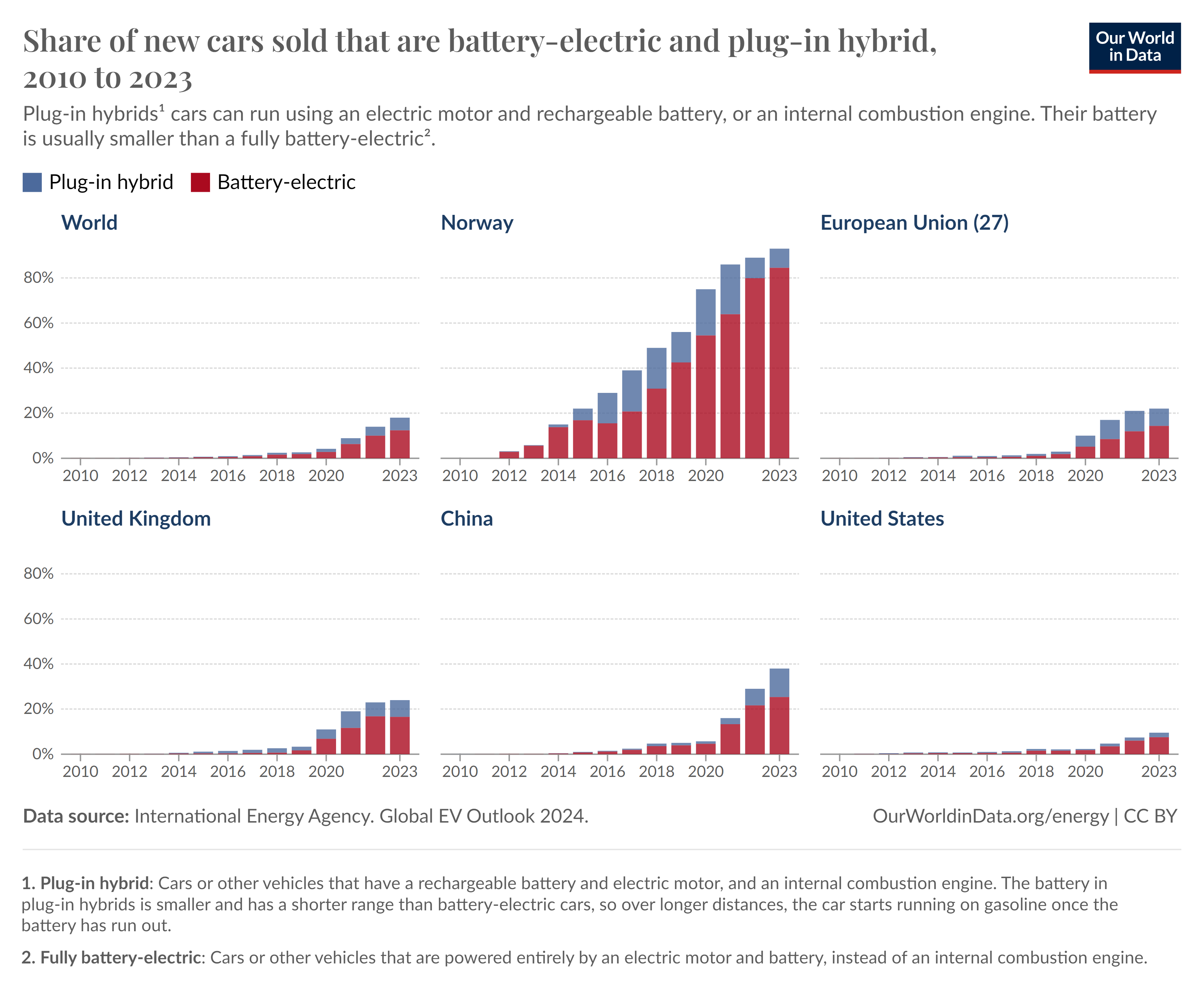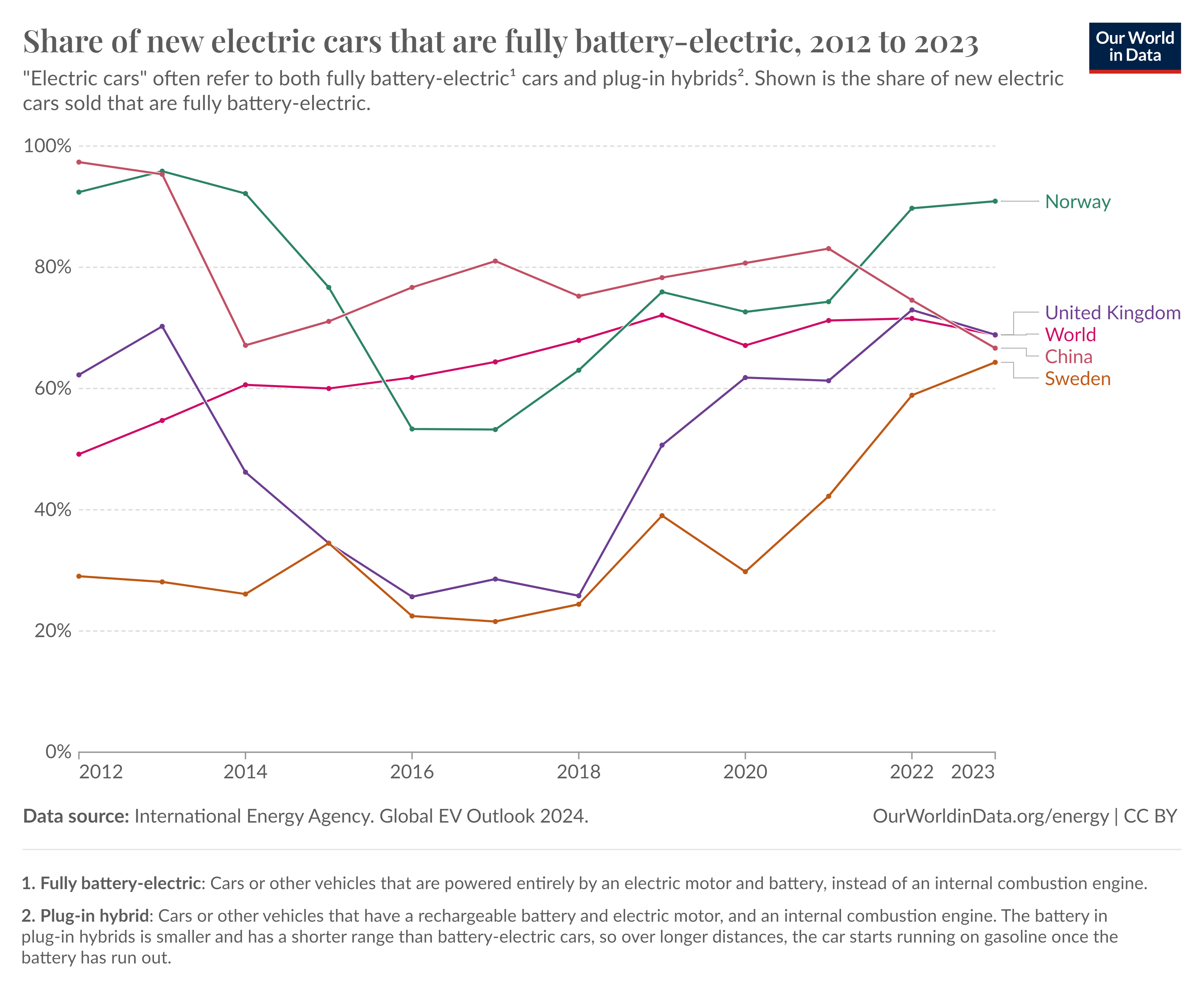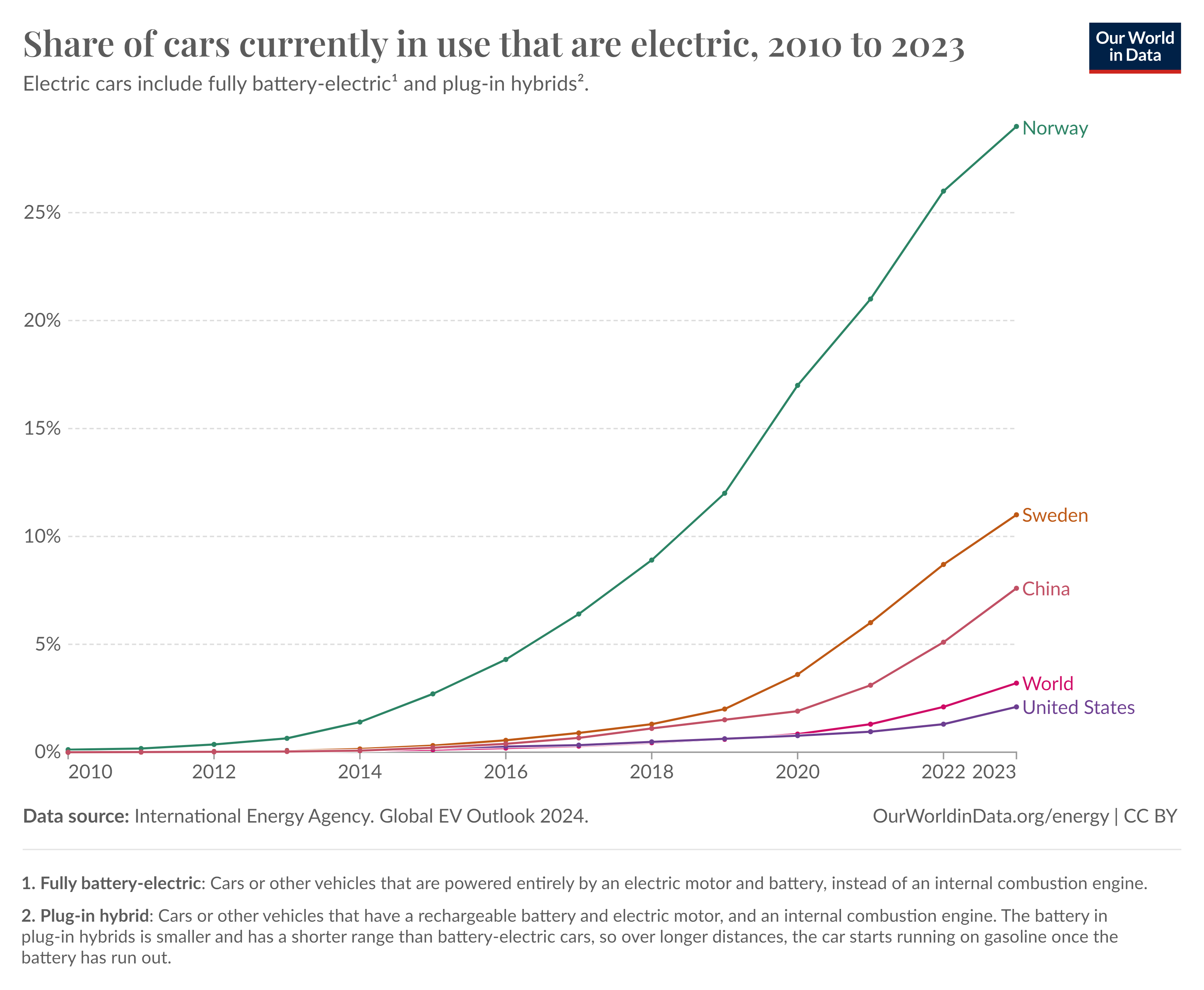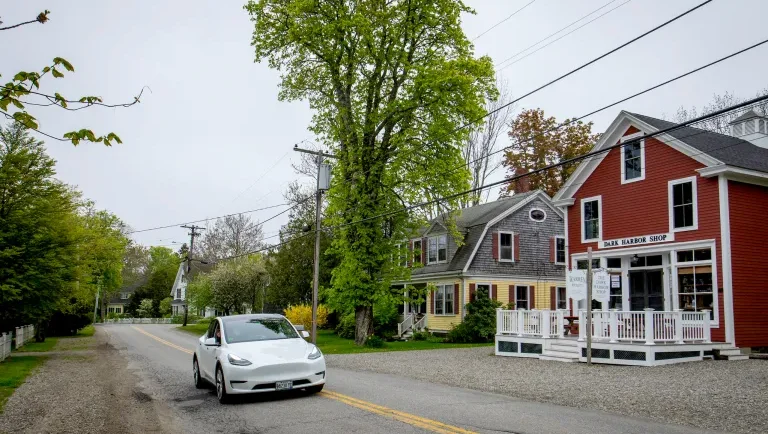Electric vehicles are an essential solution to decarbonizing transport.
Electric cars tend to have a lower carbon footprint than petrol or diesel cars over their lifetimes. While more carbon is emitted in the manufacturing stage, this “carbon debt” tends to pay off quickly once they’re on the road. The carbon savings are higher in countries with a cleaner electricity mix, and these savings will also increase as countries continue to decarbonize their electricity grids.
How quickly are countries moving to electrified transport? Which countries are leading the way?
In this article, we look at data from across the world on electric vehicle (EV) sales and the stock on the road.
This data comes from the International Energy Agency. It publishes its Global EV Outlook every year. We will update this data every time a new release is published.
Sales of electric cars started from a low base but are growing quickly in many markets.
Globally, around 1-in-4 new cars sold were electric in 2023. This share was over 90% in Norway, and in China, it was almost 40%.
In the chart below, you can explore these trends across the world.
Here, “electric cars” include fully battery-electric vehicles and plug-in hybrids.

.png)
“Electric cars” include battery-electric and plug-in hybrid vehicles. The difference is that fully battery-electric cars do not have an internal combustion engine. In contrast, plug-in hybrids have a rechargeable battery and electric motor, and an internal combustion engine that runs on gasoline.
That means a plug-in hybrid could be driven as a standard petrol car if the owner did not charge the battery. The battery in plug-in hybrids is smaller and has a shorter range than battery-electric cars, so over longer distances, the car starts running on gasoline once the battery has run out.
Since plug-in hybrids will often run on petrol, they tend to emit more carbon than battery-electric cars. However, they do usually have lower emissions than petrol or diesel cars.
In the first chart below you can see electric car sales broken down by these two technologies. This is given as a share of new cars sold each year.
In the second, you will find the share of new electric cars sold that are fully battery-electric.


The chart below shows the total number of new electric cars sold. Again, this includes fully battery-electric and plug-in hybrids.

Based on the data published by the IEA on the number of electric cars sold, and EV sales as a share of all new cars, we can calculate the absolute number of new cars of each type sold each year.
These figures suggest that global sales of non-electric cars peaked in 2018. This aligns with other estimates published elsewhere; for example, Bloomberg New Energy Finance reported that sales peaked in 2017.
You can explore this data for other countries in the chart below, too.

The cars that are on the road today represent sales data over more than a decade.
This can be captured in a metric called “stocks”. It’s an approximation of the number of cars that are in use and represents the balance of cars being added and those that are being retired.
Because people use their cars for a long time, it takes time before new sales have a visible influence on car stocks. That means the share of cars on the road that are electric is much lower than the share among new sales.
The share of cars in use that are electric is shown in the chart below.

The number of electric cars on the road is the cumulative total of sales over the years (minus any cars that have been taken off the road).
The total number of electric car stocks is shown in the chart below. There are now more than 40 million electric cars in use globally, and this is growing quickly. In 2022, this figure was just 26 million.

1. Many studies make this point. Here are just a few:
See Zeke Hausfather’s article in the Carbon Brief. Simon Evans’s fact-check on electric cars, also in the Carbon Brief.
This report is from the International Council on Clean Transportation (ICCT).
The International Energy Agency’s analysis on the life-cycle footprint.
2. The data below comes from the IEA’s Outlook for 2024.
IEA (2024), Global EV Outlook 2024, IEA, Paris https://www.iea.org/reports/global-ev-outlook-2024, License: CC BY 4.0.
3. How much lower will depend on someone’s driving and charging habits. If they recharge regularly and run mainly on the battery, its emissions will be much lower. The International Energy estimates that a plug-in hybrid emits half as much carbon as a petrol car per kilometer. But again, there are large uncertainties depending on personal usage.

MINING: The federal Bureau of Land Management finds a proposed Nevada lithium mine’s protection plan is adequate to avoid driving an endangered wildflower to extinction. (Associated Press)
ALSO:
SOLAR:
GRID:
STORAGE: A southern California tribal nation’s proposed microgrid project becomes the first long-duration energy storage system to receive a U.S. Energy Department loan guarantee. (Utility Dive)
ELECTRIFICATION: California advocates criticize the state’s new building efficiency standards for only encouraging heat pumps and other electric appliances in new homes and businesses, not existing ones. (Canary Media)
CLEAN ENERGY: A Nevada nonprofit launches a tool aimed at expanding residents’ access to federal home electrification, rooftop solar, electric vehicle and other clean energy incentives. (Las Vegas Review-Journal)
OIL & GAS: The Navajo Nation passes legislation aimed at reducing methane emissions from oil and gas facilities on tribal land. (news release)
CLIMATE: California advocates and scientists urge voters to support a $10 billion climate bond ballot measure, saying investing in resilience will save money in the long-term. (Inside Climate News)
ELECTRIC VEHICLES: Data show California has acquired, ordered or funded more than 3,000 electric school buses, more than three times that of any other state. (Canary Media)
TRANSPORTATION:

ELECTRIC VEHICLES: A $4 billion electric vehicle battery manufacturing plant set to open early next year in Kansas has potential to spur massive economic activity and transportation infrastructure upgrades, Gov. Laura Kelly says. (Flatland)
INDUSTRY: Finding customers willing to pay a premium for “green” steel made with clean energy remains a key hurdle as a major steelmaker considers new emission-reduction technology at its Ohio plant. (Canary Media)
SOLAR:
CLEAN ENERGY:
PIPELINES: Indigenous pipeline protestors say praises of Minnesota Gov. Tim Walz’s clean energy record ignore his position that allowed for the Line 3 pipeline expansion. (Mother Jones)
COAL: Converting a Michigan coal plant site to include solar as well as public beaches is part of a Chicago-based environmental group’s broader strategy to repurpose retiring coal plants across the Great Lakes region. (Bridge)
NUCLEAR: Federal regulators say a shuttered Michigan nuclear plant will need more inspections, testing and repairs to its steam generator before the plant can reopen. (WOOD-TV8)
CLIMATE: Climate action plans in southeastern Michigan include work to make community parks more resilient to storms and educating parks officials on climate issues. (Model D)
GRID: Construction is completed on a Nebraska manufacturer’s behind-the-meter microgrid powered by solar and storage, the first of its kind in the state. (Solar Power World)
BIOGAS: A new plant in Nebraska will collect biogas from wastewater streams at a major food producer’s facilities to be converted into pipeline-quality renewable natural gas. (News Channel Nebraska)
COMMENTARY: Michigan officials can maximize the benefits of $156 million in federal Solar for All funding by considering energy justice, focusing on community solar and including weatherization support for rooftop projects, a clean energy advocate writes. (Union of Concerned Scientists)

ELECTRIC VEHICLES: Owners of General Motors electric vehicles can now install adapters that allow access to Tesla supercharger stations, a move by the automaker to expand charger access and remove range anxiety as a barrier to adoption. (Forbes)
ALSO:
POLITICS: Minnesota utility executives have played an outsized role in campaign contributions to a Republican candidate looking to upset her Democratic opponent in a crucial Minnesota state Senate race. (Minnesota Reformer)
PIPELINES:
SOLAR:
EFFICIENCY: A nonprofit receives a $2.8 million federal grant to help Michigan tribal communities adopt energy-efficient building codes and climate adaptation strategies. (WisconsinInno, subscription; news release)
RENEWABLES: City officials in Kalamazoo, Michigan, approve a 20-year contract with Consumers Energy to buy enough wind and solar to power all municipal buildings by 2028. (MLive)

ELECTRIC VEHICLES: The first electric U.S. Post Office trucks are on the road in Georgia and already winning praise from drivers who prefer them to the previous hot, noisy and inefficient combustion vehicles. (Associated Press)
ALSO:
UTILITIES:
CLEAN ENERGY: Texas’ plans to build solar, wind and battery projects over the next year and a half dwarf those of any other state, including second-place California. (Canary Media)
HYDROGEN: Utilities in Florida, Georgia, Louisiana and Texas are converting existing power plants and building new ones to blend hydrogen with natural gas in an attempt to decarbonize their emissions. (Power Engineering)
CLIMATE:
SOLAR: High interest rates, labor shortages, and foreign competition are jeopardizing the buildout of a domestic solar supply chain, industry leaders say. (Utility Dive)
ELECTRIFICATION: Colorado officials look to regulations, rebates and marketing to prod restaurants to convert from natural gas to electric stoves. (CPR)
GEOTHERMAL: Well tests determine an enhanced geothermal generating station in southwestern Utah is the most productive of its kind in history. (Utility Dive)
COMMENTARY: A professor says the bipartisan permitting bill in Congress is a “Faustian bargain” that expedites fossil fuel development but does little to help clean energy. (Bulletin of the Atomic Scientists)

ELECTRIC VEHICLES: Unionized workers at an Ohio electric vehicle battery manufacturing plant lament the partisan divide over EVs, noting that the industry has helped preserve good-paying jobs. (Inside Climate News)
ALSO:
PIPELINES:
UTILITIES: Four years since the first arrests were made in the Ohio power plant bailout scandal, the federal government has yet to charge any FirstEnergy executives for their role in the alleged bribery scheme. (Cleveland.com, subscription)
NUCLEAR: Total subsidies for supporting the restart of a Michigan nuclear plant reach $2.4 billion as pushback from anti-nuclear activists intensifies. (Bridge)
GRID:
CLEAN ENERGY: State and federal legislation and incentives have helped make Michigan a national leader in clean energy projects and job creation, according to a new report from clean energy analysts. (Metro Times)
SOLAR: Concerned rural landowners in southeastern Nebraska want local officials to adopt zoning regulations for commercial solar development as a company pursues a 100 MW project there. (News Channel Nebraska)
CLIMATE: The second annual Chicago Climate Tech Week returns next week with various events focused on clean energy innovations that are expected to draw about 3,000 people. (Chicago Sun-Times)

It’s been nearly 20 years since states and cities started adopting climate goals, setting themselves on a path toward reducing emissions and rolling out clean energy. Whether they’re actually on track to meet those goals is up for debate.
Advocates across the country have sued municipalities they say are failing on their climate commitments, like those in San Diego who alleged the city’s climate plan lacked funding and a clear timeline, and a group in Vermont that said the state wasn’t complying with its 2020 emissions law.
But in Maine, climate advocates are getting specific with their complaints, the Energy News Network reports. A pending youth-led lawsuit targets the state’s environmental protection agencies, and says they haven’t adopted strong enough regulations to propel the state’s electric vehicle rollout.
The suit centers on Maine’s 2019 climate law. In it, the state said it would focus on cutting emissions from its “most significant sources” — and transportation tops that list. But even though the state has incentivized electric vehicle adoption, it’s still far from meeting its EV goals. So advocates say the state should implement California’s strongest-in-the-nation EV standards, which go even further than federal rules.
Environmental law professor Jennifer Rushlow told ENN that narrow lawsuits like this one tend to be more successful than broad suits that “get kind of lost to politics.” — and can inspire change in public opinion, too.
Read more about Maine’s unique climate lawsuit at the Energy News Network.
💰 More federal spending is coming… Researchers estimate the clean energy transition by 2031 will demand $1 trillion in federal spending — about 15 times what has been distributed so far via the Inflation Reduction Act. (Grist)
🏭 But is it all smart? The U.S. has spent more public money on carbon capture and gas-produced hydrogen than any country, a new report finds, even though the technologies remain unproven as cost-effective climate solutions. (The Guardian)
♻️ A new spin for wind: National Renewable Energy Laboratory researchers say they’ve developed a wind turbine blade made from plant materials that can be recycled into new shapes or blades. (New York Times)
👷 Clean jobs report: The Department of Energy says clean energy jobs last year grew at twice the rate of other sectors and saw unionization rates higher than in the broader energy industry. (Reuters)
Dig deeper: The Bureau of Labor Statistics says wind energy is the country’s fastest growing field and projects 60% job growth over the next 10 years. (Axios)
🚘 More power for charging: The Biden administration announces $521 million in grants for electric vehicle charging, and says the number of publicly available chargers has doubled since 2021. (Utility Dive)
☀️ Solar’s bright future: A columnist details how increasingly cheap and widely available solar power will make once-far-fetched applications and technologies possible. (New York Times)
🇺🇲 Plus, some politics
📢 We want to hear from you! Send us your questions, comments, and story tips by replying to this email.
💸 Support our work: The Energy News Network is powered by support from readers like you. If you like Energy News Weekly, share it with a friend! Or give today and help us keep our news open and accessible for all.
📧 Want more energy news? Sign up for our daily digests.

ELECTRIC VEHICLES: The Army Corps of Engineers will reassess the permit it awarded to Hyundai’s planned $7.6 billion electric vehicle and battery factory in Georgia because it says state and local agencies never mentioned the company’s plans to withdraw up to 6.6 million gallons per day from an underground aquifer used for drinking water. (Associated Press)
GRID:
SOLAR: Nonprofits plan to expand a solar cooperative in El Paso, Texas, even though higher inflation and interest rates dampened interest in the program this year. (El Paso Matters)
STORAGE:
OIL & GAS:
GEOTHERMAL: A Houston-based geothermal energy startup signs a deal to build a facility to eventually provide 150 MW to Meta, which owns Facebook and Instagram. (Houston Chronicle)
NUCLEAR: The director of a University of Kentucky energy center tells state lawmakers nuclear companies are increasingly considering building in the state, but construction of a new nuclear reactor won’t likely occur for at least a decade. (Kentucky Lantern)
CARBON CAPTURE: A Louisiana timber company sells carbon credits for unharvested trees on 100,000 acres, including more than $100 million worth of credits through the end of 2023. (WWNO)
CLIMATE:
COMMENTARY:

ELECTRIC VEHICLES: More than a year after Tesla said it would open its Supercharger network to drivers of other electric vehicles, most chargers still remain inaccessible due to software delays and hardware shortages. (New York Times)
ALSO:
GEOTHERMAL:
OIL & GAS: Northeast states are leading the way in pursuing compensation from oil companies for economic damages from climate change. (Stateline)
GRID:
SOLAR:
CLIMATE: A study finds an increase in heat-related deaths between 2018 and 2023, with the vast majority of fatalities occurring in California, Arizona, Nevada and Texas. (Los Angeles Times)

ELECTRIC VEHICLES: Boston will be able to install at least 300 electric vehicle chargers across the city, focusing on environmental justice communities, using a $15 million federal grant, while Massachusetts park officials will install as many as 40 chargers using a $1.2 million grant. (Boston.com, WHDH)
ALSO: New York City will use a $15 million federal grant to install 600 level-2 curbside chargers throughout the city, although some criticize the plan for permanently taking away street space for other non-private car uses. (amNY, Streetsblog)
POLITICS: Maryland’s election this fall for a U.S. Senate seat could make or break federal climate action. (Inside Climate News)
RENEWABLE POWER:
GEOTHERMAL: A geothermal pilot project in Massachusetts is a rare example of gas companies and environmental activists partnering together for climate action. (Christian Science Monitor)
AFFORDABILITY:
GRID:
BUILDINGS:
TRANSPORTATION: